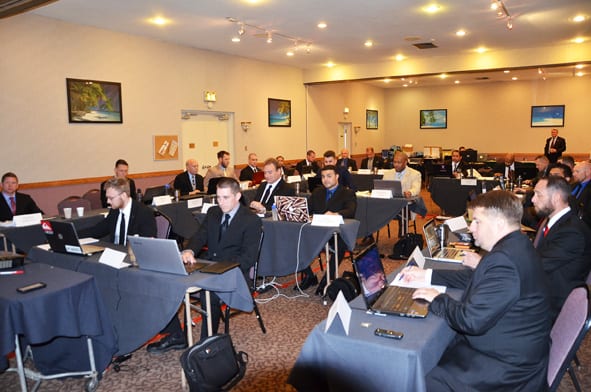From Cybersecurity to Physical Steps: Strengthening Corporate Protection in an Altering Globe
In today's quickly developing electronic landscape, the significance of corporate security can not be overemphasized. As cyber threats end up being widespread and progressively sophisticated, companies should surpass traditional cybersecurity actions to secure their assets and operations - corporate security. This is where the integration of physical safety actions becomes vital. By incorporating the staminas of both cybersecurity and physical protection, companies can produce a comprehensive protection approach that deals with the diverse series of threats they face. In this conversation, we will explore the altering hazard landscape, the demand to integrate cybersecurity and physical safety, the implementation of multi-factor verification steps, the significance of employee recognition and training, and the adjustment of protection procedures for remote labor forces. By examining these crucial locations, we will certainly gain valuable insights right into just how companies can reinforce their corporate safety in an ever-changing globe.
Comprehending the Altering Risk Landscape
The progressing nature of the modern-day globe requires a comprehensive understanding of the altering hazard landscape for efficient company safety. It is crucial for organizations to stay educated and adapt their safety and security gauges to resolve these evolving threats.
One key element of comprehending the transforming hazard landscape is identifying the different types of risks that companies deal with. Additionally, physical hazards such as burglary, vandalism, and business espionage continue to be common problems for organizations.
Monitoring and evaluating the danger landscape is important in order to recognize prospective risks and vulnerabilities. This entails staying updated on the latest cybersecurity fads, evaluating danger knowledge reports, and carrying out normal risk evaluations. By comprehending the altering risk landscape, companies can proactively carry out suitable protection measures to mitigate dangers and safeguard their assets, track record, and stakeholders.
Integrating Cybersecurity and Physical Security
Integrating cybersecurity and physical safety is vital for detailed corporate defense in today's interconnected and digital landscape. As organizations significantly count on modern technology and interconnected systems, the limits between physical and cyber risks are coming to be obscured. To properly secure versus these risks, an alternative strategy that combines both cybersecurity and physical protection procedures is necessary.
Cybersecurity concentrates on securing digital possessions, such as networks, systems, and information, from unapproved accessibility, interruption, and theft. Physical safety and security, on the other hand, includes procedures to secure physical assets, individuals, and centers from susceptabilities and threats. By integrating these two domains, companies can deal with vulnerabilities and threats from both physical and digital angles, thus improving their overall protection pose.
The assimilation of these two techniques enables an extra extensive understanding of security threats and enables a unified response to events. For instance, physical accessibility controls can be enhanced by integrating them with cybersecurity methods, such as two-factor verification or biometric identification. Cybersecurity measures can be matched by physical security procedures, such as monitoring cameras, alarms, and safe gain access to factors.

Carrying Out Multi-Factor Verification Measures
As organizations significantly focus on extensive security procedures, one reliable method is the execution of multi-factor verification actions. Multi-factor authentication (MFA) is a safety technique that requires users to give multiple forms of identification to access a system or application. This strategy includes an additional layer of defense by incorporating something the individual knows, such as a password, with something they have, like a security or a finger print token.
By applying MFA, organizations can significantly boost their safety posture - corporate security. Typical password-based authentication has its constraints, as passwords can be conveniently compromised or neglected. MFA alleviates these risks by including an additional authentication element, making it a lot more tough for unauthorized individuals to get to sensitive details
There are a number of kinds of multi-factor verification approaches offered, consisting of biometric authentication, SMS-based confirmation codes, and hardware tokens. Organizations require to analyze their details requirements and choose the most suitable MFA solution Recommended Reading for their requirements.
Nevertheless, the application of MFA ought to be carefully planned and carried out. It is vital to strike a balance between safety and use to avoid individual disappointment and resistance. Organizations ought to likewise consider prospective compatibility problems and offer sufficient training and assistance to make certain a smooth shift.
Enhancing Staff Member Understanding and Training
To reinforce corporate protection, organizations need to focus on boosting employee awareness and training. Numerous protection violations take place due to human mistake or absence of awareness.
Reliable employee understanding and training programs should cover a wide variety of subjects, consisting of information security, phishing strikes, social design, password health, and physical safety and security measures. These programs must be customized to the certain requirements and obligations of different employee roles within the organization. Regular training simulations, workshops, and sessions can aid staff members establish the needed skills and knowledge to react and recognize to safety and security threats successfully.
Additionally, companies ought to encourage a society of security recognition and supply ongoing updates and suggestions to keep employees educated about the most up to date hazards and reduction strategies. This can be done with internal interaction check my blog channels, such as e-newsletters, intranet portals, and e-mail projects. By fostering a security-conscious workforce, organizations can significantly minimize the possibility of security cases and secure their valuable possessions from unapproved access or compromise.

Adapting Safety Measures for Remote Workforce
Adjusting company safety procedures to suit a remote workforce is vital in making certain the security of delicate details and assets (corporate security). With the raising fad of remote job, organizations should execute appropriate safety steps to mitigate the threats connected with this brand-new way of working
One crucial element of adjusting safety and security actions for remote job is developing secure interaction networks. Encrypted messaging platforms and virtual exclusive networks (VPNs) can assist safeguard sensitive info and prevent unauthorized gain access to. Additionally, companies need to impose the use of strong passwords and multi-factor verification to improve the safety and security of remote accessibility.
An additional vital factor to consider is the execution of safe and secure remote gain access to remedies. This includes giving employees with protected access to corporate sources and information through digital desktop framework (VDI), remote desktop computer procedures (RDP), or cloud-based options. These innovations make sure that delicate details remains protected while enabling employees to execute their functions effectively.

Last but not least, comprehensive safety understanding training is important for remote staff members. Educating sessions must cover best practices find this for securely accessing and handling sensitive details, identifying and reporting phishing attempts, and keeping the total cybersecurity health.
Final Thought
In verdict, as the danger landscape proceeds to progress, it is important for organizations to reinforce their safety measures both in the cyber and physical domains. Incorporating cybersecurity and physical safety, executing multi-factor verification procedures, and improving worker awareness and training are crucial steps in the direction of accomplishing robust company protection.
In this conversation, we will certainly check out the changing danger landscape, the need to incorporate cybersecurity and physical security, the execution of multi-factor verification measures, the relevance of employee recognition and training, and the adaptation of security actions for remote workforces. Cybersecurity procedures can be enhanced by physical safety and security actions, such as surveillance electronic cameras, alarms, and safe accessibility points.
As organizations increasingly prioritize detailed security steps, one efficient technique is the implementation of multi-factor authentication procedures.In verdict, as the threat landscape continues to advance, it is essential for companies to reinforce their protection measures both in the cyber and physical domains. Incorporating cybersecurity and physical protection, implementing multi-factor authentication steps, and boosting worker recognition and training are essential steps towards achieving robust business safety.